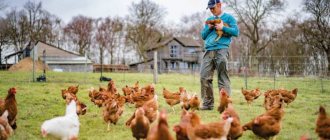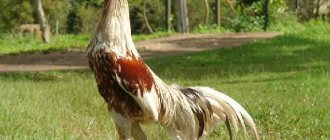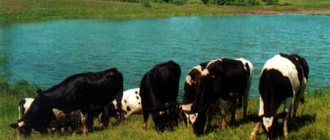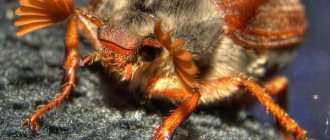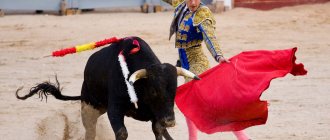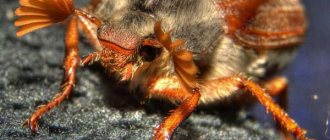The crow of a rooster became a natural alarm clock for villagers. For many centuries, this bird loudly and continuously announced that the sun had risen and a new day had begun. However, it is possible to hear the male's crowing throughout the day, even at night. Some roosters crow louder and longer than others, and in different countries it differs. But they start singing at a certain age. Read about this and much more in our article.
Age for crowing
There are different breeds of roosters: some crow louder, others quieter, and others longer. But the overwhelming majority crow.
A male, to whom nature has not given the opportunity to communicate with his relatives by crowing, is discarded.
Let's figure out at what age roosters begin to crow. After hatching, the chicks' vocal cords are not yet strong enough to scream loudly and for a long time. Up to 3 months these are squeaking chicks.
Next, the chicken begins to practice singing. But this is still the formation of the voice, reminiscent of a squeak with a slight hoarseness. And already at 4-5 months, the young rooster begins to make sounds that are no different from the singing of adult males.
Preparation and sale of carcasses
When to send for slaughter
It is better to slaughter roosters for meat at 2.5-4 months. There is no point in raising and fattening them any further. Males gain weight slowly and need a lot of food.
Find out more in the article “How to slaughter chickens at a poultry farm and at home.”
Where can I sell it?
Fattened roosters can be slaughtered and kept for yourself. Or implement it. Information about the sale is posted in the newspaper or on popular classifieds websites. The news “We sell meat” is often found there.
If you raise a lot of roosters, you can enter into an agreement with supermarkets in Moscow and other large cities. If there are few carcasses, sell them at the market.
This is interesting
It is noteworthy that males speak different languages in their own way:
- The crow of a rooster in Russia sounds like a crow.
- In Japan, the male says - koke-koh-koh.
- In Germany, the cockerel crows - kike-ri-ki.
There are also specially bred singing breeds of roosters. For example, Yurlovskaya vociferous. They begin to develop vocal cords much later than others, at the age of 9-10 months. Their voice becomes completely stronger as the year approaches.
It is also interesting to observe the sounds the chicken makes. According to statistics, the female constructs up to 30 sentences from the sounds made in her language.
When a chicken sings, you can notice how the production of pronounced sounds, intonation and timbre changes.
For example, chickens cluck very excitedly if they feel danger or stress. If you give a female a rooster, her cackling will be inviting. And over the hatched chickens she clucks like a hen.
Chickens can communicate
People think that chickens communicate with each other simply by clicking and clucking, but in fact, it is the language of communication. Researchers have described over thirty different meanings of bird “conversation,” including “it’s time for me to get laid,” “come quickly, everyone is here, there’s a lot of food!”, as well as the call of partners during the mating season and a signal about the approach of predators. Mother hens can quietly communicate with embryos that are still in the egg. And a few days before birth, chicks can already respond to their mother with certain sounds expressing pleasure or anxiety, if the mother herself is calm or anxious.
Later, while walking with the brood, the quonka constantly teaches the chicks, making various sounds warning of danger, or calling them to peck something, and the babies quickly respond to the call, hiding under their mother or gathering in a group near the food.
Hierarchy and other features
The order of cockcrow is determined by the hierarchy. The leader of the herd sings first. Following him are males one step lower in status.
If a young man speaks up early and stops observing the laws, he may be pecked to death. Or make him an outcast for excessive insolence. On the other hand, any cockerel is given the opportunity to prove its superiority.
To a farmer, the crowing of a rooster can indicate various problems in the flock. We give examples below. Also, by singing males you can set your watch.
Not so long ago, in villages and villages, the crow of a rooster was a reference point for time. Most farmers woke up and started working on the farm with the first roosters.
A rooster can live without a head
It happens that after slaughter, a chicken can move for some time even without its head. This happens because the body of a headless bird continues to produce nerve impulses.
A similar incident occurred in 1945 in the town of Fruita in the USA, on the farm of L. Olsen. To prepare dinner, the farm owner decided to slaughter a rooster named Mike, but missed and cut off only a fragment of the unfortunate bird’s head with an ax, leaving one ear and part of the brain stem. The wounded rooster jumped up and began to run around the yard.
The bird was left alive for the sake of an experiment: how long it could live in this way. The rooster was fed milk from a pipette, dropping it directly into the throat. Scientists from the University of Utah became interested in this case, who documented this phenomenon and determined that the rooster survived due to the fact that the carotid artery was not damaged during the ax blow. Also, the part of the brain that remained unharmed was responsible for the vital functions of the body and allowed the rooster to survive.
Mike subsequently recovered from his injury and was able to live another 18 months. During this time, L. Olsen participated with Mike in public demonstrations of this phenomenon, but one day after the tour he forgot to feed him, after which the rooster died (or suffocated from a ruptured trachea, according to another version). Mike’s case is one of a kind, so it took an honorable place in the Guinness Book of Records.
Celebrating Mike the Headless Chicken Day Subsequently, the headless rooster became a symbol of the town of Fruita and every May they hold “Mike Day” there, during which they organize an egg throwing competition.
Did you know? Although most people are fascinated by fluffy, tiny chickens, some people have alektorophobia - the fear of chickens and chickens. Suffering from this disorder, such people fear that birds may behave aggressively and, hiding, attack them.
Why does the rooster crow
Roosters never speak without a reason. There is an explanation for any singing.
Chickens always have a leader. This is the alpha male, the strongest rooster, who has managed to prove his superiority over others. He controls the flock with his crowing.
The crowing of a rooster can indicate that feeders or drinking bowls are empty.
Another reason for rooster crowing can be a change in weather conditions or atmospheric pressure.
Late in the evening the herd has a roll call. This explains why the rooster crows at night. There is no need to be afraid of evening activity; this is normal.
With a loud cry, the male can challenge an opponent to fight.
In the middle of the day, the cockerel and hen sing to solve pressing problems.
Let's figure out why roosters crow in the morning and at other times of the day.
Popular beliefs
All these are facts, but even more is said about this amazing bird in folk wisdom. The following interesting things can be highlighted from this source:
- The rooster is the master of the village farmstead. By observing the behavior of birds, our ancestors made forecasts for the weather, crop yields and livestock growth;
- There were signs associated with the crowing of a rooster. For example, if you are getting ready for an important event the day before, and if a rooster wakes a person up in the morning, then everything will turn out well. It was believed that by crowing at different times of the day, the rooster attracted good luck to its owner’s yard, and the louder and louder, the better;
- It was not customary to keep a pair of roosters, because they believed that this would bring discord and problems to the house. The excess amount was sold at the market or exchanged, which attracted great luck. It was necessary to take something for the bird, even from loved ones, because “to give for nothing is to throw away”;
- If a rooster crows on a gate or perch in a house where there is a girl, then they will soon come to woo her;
Interesting: Why are sharks afraid of dolphins?
Reasons, photos and videos They also believed that the crowing of a rooster at any time is a sure cure for “evil people.”
Scream at different times
The rooster crows several times during the night, in the morning and during the day. Let's find out exactly what time he starts crowing.
Numerous observations show that the rooster crows at night at one and two. In the morning, his cry invariably begins at 4 o'clock.
For many, it remains a mystery how the rooster determines the time to crow. Japanese scientists have concluded that the male's calls directly depend on the appearance of stars in the sky.
Biological clock is another reason that causes rooster crows. The bird clearly senses time intervals. This leads to a loud notification to the herd about the passage of a certain time.
Mother hens
Brood hens lay eggs and sit on them until the chicks hatch. They need privacy. If a person or other birds disturb her during this action, she may growl. Yes, can you imagine, a chicken can roar! In this way she warns that she should not be disturbed - the hen wants to become a mother. If you do not move away from the nest in time, the hen will begin to painfully peck the troublemaker until he leaves.
Some hens make sounds like squealing or even screaming, and also fluff up and look with an angry look, trying to ward off the uninvited guest with all their appearance.
Typically, a brood hen leaves the nest once a day. At this moment, she fluffs up her feathers, clucks quite often and always looks a little irritated. Most likely, this is the chicken’s way of showing that now it is better not to disturb her or touch her.
If you observe, you will notice that other birds avoid the hen. Thus, she shows herself in the role of a “good mother” who will always be able to protect her offspring.
Scream volume
The volume of a cockerel's crow can reach 90 decibels. A dog's barking, for example, is not much different from crowing.
A crowing rooster is much quieter than the engine of an old tractor plowing a field. Some electric instruments operate with louder sounds.
But the crow of a rooster can become an irritating factor for an unprepared person. This is because males cannot be silenced at night or early in the morning. All the same dogs can be weaned from barking.
Frequency and duration of singing
In the wild, cockerels vocalize more often than their domesticated counterparts. After all, at home, many irritating factors disappear.
During the day, males speak more often, due to a more intense pace of life. At night the rooster crows a couple of times. It is also enough for him to notify the herd about dawn or sunset 2-3 times.
How a rooster crows and the duration of its crow also depends on the variety. On average, a song lasts from 5 to 25 seconds. Representatives of some vocal breeds can hold a note for a minute.
If the cockerel begins to crow frequently and heart-rendingly, this may indicate a problem. Especially if he is not a vocal breed. In such cases, it is recommended to check the situation in the chicken coop.
How a rooster impregnates a hen and the age of sexual maturity
The chicken’s body functions in such a way that in order for eggs to appear, it only needs to reach maturity. It can occur between 5 and 8 months of age, depending on the breed. Immediately after reaching sexual maturity, the chicken lays eggs.
Their size, shell color, and frequency of appearance depend on several factors:
- Breeds;
- Diet;
- Conditions of detention.
In order to lay an egg, a chicken needs no more than 2 days.
The formation process occurs as follows:
- The egg matures in the ovary;
- It leaves the follicle and enters the oviduct;
- The formation of the egg begins in it: the yolk, white and shell appear;
- Upon completion of the process, the egg begins to move towards the exit outside.
In order for the process of laying eggs to occur regularly, the hen does not need a rooster. Her body itself performs the tasks assigned by nature.
The male is necessary for the fertilization process, after which the embryo, the future chicken, begins to develop in the egg.
Chicken mating games
Chickens are gregarious birds that live exclusively in groups. In each such family group there must be a leader - this is the largest male who is able to defend his rights by force.
Indeed, there are fights between males for primacy, and quite fierce ones. Sooner or later, the younger rooster defends the right to be the leader of the flock, and the old leader retires.
We invite you to familiarize yourself with the folk signs of autumn. Autumn signs for children and schoolchildren
The leader has the right to copulate with any female whenever he wants. The rest of the roosters will do this when the leader allows it. When a male flirts with a female, he walks around her and scratches her wing with his foot. Shares food with her, shows certain signs of attention that are important for birds.
The expression “a rooster tramples a hen” is common due to the fact that the female has a hole on her back and the rooster, moving his paws over it, tries to find it in order to understand whether he was aiming correctly. The picture of sexual intercourse itself is quite rigid; fertilization in birds is a unique process. The rooster is on top and holds the female by the back of her head with his beak.
This process is short-term and often repeated. If a male is abnormally active in terms of sexual activity (about 22 matings per day), then this can reduce the concentration of his seminal fluid by half. If the number of copulations is limited, this will increase the percentage of fertilized eggs, as well as the viability of future chicks.
Weaning off night chants
The crowing of roosters cannot be trained. And it will not be possible to completely wean him from crowing. The following actions will help reduce the number of screams per day.
You need to check the chicken coop for holes - they should be concreted. Rats and mice crawl through them, scaring the birds.
It is advisable to make a fence about 40 cm deep around the perimeter of the chicken coop. This will also protect the birds from intrusion by uninvited guests. As well as special traps.
You can give a particularly noisy rooster to another flock.
To prevent the rooster from crowing, you can use a special Velcro collar. It is sold in veterinary pharmacies and specialty stores.
Operating principle: the collar slightly compresses the cockerel’s neck, preventing it from taking in full lungs of air for a long and loud cry. According to reviews, the device is safe for birds. And after a few days, a habit develops.
How to make a rooster silent?
Attention! It is impossible to stop a rooster from crowing. If his screaming irritates you, choose a quieter breed. But even they demonstrate a ringing voice every morning.
To keep the bird silent at night, provide it with peace. There should be no openings in the chicken coop through which predators and rodents can enter the building. In the shed, place a feeder with grain, beans or other food.
Be sure to read:
Fertilizer from chicken manure: composition and use, how to dilute it for feeding
If this does not help, use improvised means. Buy a Velcro strap 5 cm wide from a textile store. Wrap it around the rooster’s neck (not tightly). The bird will not be able to take in enough air to crow loudly.
It does not harm the birds. On the 3-5th day they will get used to the “collar” and will no longer feel it. As the strap wears out, the strap changes, and sometimes chickens throw it off.
Advice! If you do not want to cause any inconvenience to your betta, seal the walls of the barn. The chickens' calls will be more muffled.
Reasons for stopping crowing
One out of two
There are times when the rooster crowed, and then suddenly and for a long time fell silent. There is an explanation for this too.
In some cases, normal physiological processes become the cause. In others, the sudden silence of the leader of the herd should be alarming.
Change of plumage
Cockerels moult in the second half of autumn. During this period, even the most active leader becomes less active and refuses to eat. Stops crowing, which is caused by a decrease in the production of thyroid hormones.
Molting lasts about 2.5 months. The later it starts, the shorter the daylight hours. This means the process takes longer. You can increase daylight hours by using artificial lighting. And then the pen change will be faster.
As soon as the molt passes, the singing continues with the same force.
Depressive state
It may be that the rooster stopped crowing due to a drop in self-esteem. That is, he personally stopped considering himself a brave and cocky leader.
Most often this occurs after a serious illness. Or after removal of the testes, when the male is no longer interested in the hens.
Aging and breed characteristics
With age, primacy is transferred to young, strong individuals. An aging male sings hoarsely and not so loudly. Over time, the voice disappears completely.
Hormonal changes and illness
A malfunction in the hormonal system of the cockerel also provokes the cessation of singing. Hormonal problems should be treated with the help of a veterinarian. Sometimes the voice does not recover after treatment.
A male’s voice may also disappear due to illness:
- bronchopneumonia;
- colibacillosis;
- infectious bronchitis;
- respiratory tract diseases.
Learn more in the article “Symptoms and Treatment of Common Chicken Diseases.”
What does a rooster eat?
Photo: Rooster bird
Ordinary roosters are practically omnivorous. They are indiscriminate eaters and are able to feed on both plant and animal food. When grazing freely, roosters eagerly peck at green young grass, pick up seeds, and dig up roots.
Roosters rake the ground with their paws, looking for the most delicious food. They can eat worms and insects, and can even chase lizards. Sometimes small mice become their prey. If a rooster catches large prey, he throws it up with his beak and cackles, inviting other chickens to feast on the meat.
Roosters do not need much water because they get most of their fluid from green grass. Roosters drink by putting their beaks into the water and throwing back their heads, thus swallowing it. Meat breeds of roosters are fattened using various nutritional supplements.
In general, roosters are fed the following components:
- vegetables and fruits;
- grain - oats, millet, barley, millet and so on;
- bran;
- eggshells crushed into powder are important for the growth of chicks;
- Low-fat cow's milk can be added to dry food for a calcium supplement;
- special vitamin complexes for farm birds.
Now you know what to feed the rooster. Let's see how it lives in its natural environment.

